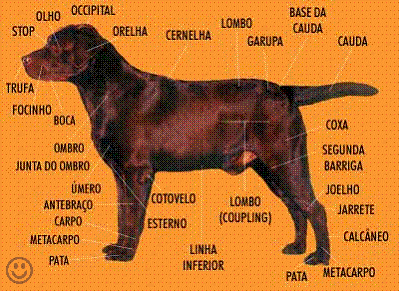
1947, AMERICAN STANDARD

The general appearance of Retriever of Labrador owes being of strong constitution, short trunk and very assets. He should be sufficiently wide in the loin, and strong and muscular in the subsequent ones. The coat should be closed, short, dense and without bangs.
The skull should be wide, giving space to the brain: it should have a light stop, that is, the forehead should be pronounced lightly, so that the skull is not absolutely in straight line with the snout. The head should have a defined drawing and free from fleshy cheeks. The maxillaries should be long and strong and free from cuttings; the snout should be wide and the nostrils well developed. The teeth should be strong and regular, with the bite in torquês. The ears should be carried falls, moderately nearby to the head, preferentially inserted well behind, and in certain way low without being big and heavy. The eyes should be of medium size, expressing great intelligence and good temperament, and they can be brown, yellows or black, but brown and blacks are preferable.
The neck should be of size medium, strong and without dewlaps. The shoulders should be long and sloping. The trunk should be wide and deep, the very arched ribs and the wide and strong loin, elegant waist, and the subsequent good developed and of great power.
The legs should be straight from the shoulders to the ground, and the compact paws, with the very arched fingers and cushions you plant well developed, the hocks should be well angulados, and the dog should neither have cow hocks nor open hocks; in the reality, he needs to sustain and to move in all of the directions the legs and paws. The legs should be of medium size, showing good skeleton and musculature, but no so short that it is out of balance with the rest of the body. In the reality, a very balanced dog in all of the aspects is preferable to a dog with impressive qualities and defects.
The tail is a peculiar characteristic of the race; it should be very thick in the base, gradually being narrowed for the tip, of medium size, free from any type of bangs, and it should be covered thickly in all his/her extension by the coat tans, thick and dense characteristic of the race, giving the cylindrical" peculiar" aspect that it was described with" otter" tail. She can be carried high, but it doesn't owe if it curves on the back.
The coat is another peculiar characteristic; she should be tans, very dense and without undulations, and he/she should give a sensation of being reasonably rough to the touch.
The colors are black, yellow and chocolate and they are described to proceed:
The movement should be free and effortlessly. The previous legs should be strong, straight line, appropriate and correctly inserted. Observing a labrador moving in his/her direction, they should not have signs of elbows opening up, but harmoniously staying the body close to, without the legs join, and moving directly ahead without to march or to sway. Looking at the dog for back, he/she should give the impression of the back legs be muscular and without cow hocks, moving as parallel as is possible, with the hocks making the whole work and being inflected well, this way giving the impression of power and force.
The approximate weight of dogs and female dogs in work conditions: Dogs, 60 to 75 Pounds (27 to 34 Kg); female dogs, 55 to 70 pounds (25 to 32 Kg).
Height in the withers: Dogs, 22½ to 24½ inches (57 to 62 cm); Female dogs, 21½ to 23½ inches (55 to 60 cm).